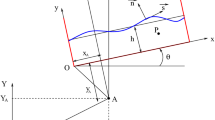Abstract
The interaction between a boundary layer and a supersonic flow past a plate with a flap deflected at a small angle in the presence of strong cooling of the body surface is considered. For supercritical regimes, the entire interaction region is located behind the leading edge of the flap and the pressure distribution has a discontinuity of the derivative near the corner point. The flow in a break-point neighborhood with a characteristic length Δx of the order of the boundary layer thickness is studied. It is shown that in this region a substantial pressure difference arises. The pressure distribution along the surface is found. The viscous sublayer in this region develops under the action of the given pressure gradient.
Similar content being viewed by others
REFERENCES
V. Ya. Neiland, “Specific features of boundary-layer separation on a cooled body and its interaction with a hypersonic flow,” Izv. Akad. Nauk SSSR, Mekh. Zhidk. Gaza, No. 6, 99–109 (1973).
V. Ya. Neiland and L. A. Sokolov, “Towards an asymptotic theory of the onset of separation near a flap in flow past a cooled body in the weak hypersonic interaction regime,” Uchen. Zap. TsAGI, 6, No. 3, 25–34 (1975).
V. S. Naumov, “Standard matrix sweep computer program in the Fortran-Dubna language,” Trudy TsAGI, No. 2093, 19–30 (1981).
Rights and permissions
About this article
Cite this article
Konotop, T.V., Sokolov, L.A. Specific Features of the Flow in the Supercritical Boundary Layer Near a Break Point on a Cold Surface. Fluid Dynamics 37, 403–409 (2002). https://doi.org/10.1023/A:1019606506929
Issue Date:
DOI: https://doi.org/10.1023/A:1019606506929




